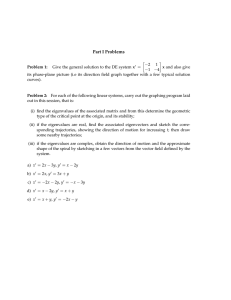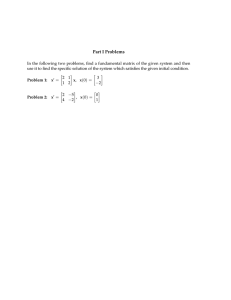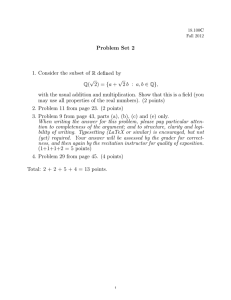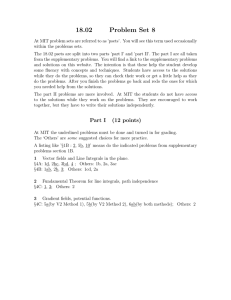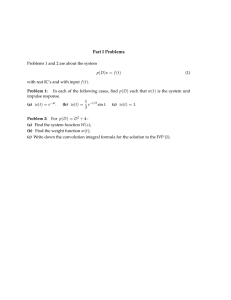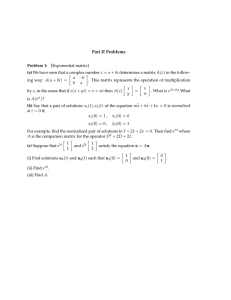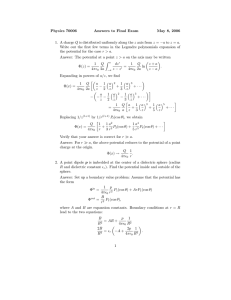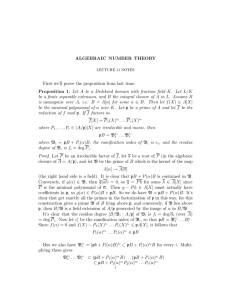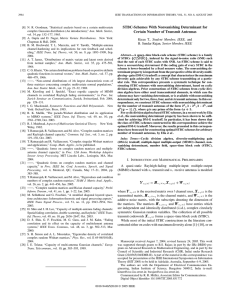ALGEBRAIC NUMBER THEORY 1. Section 1.1
advertisement
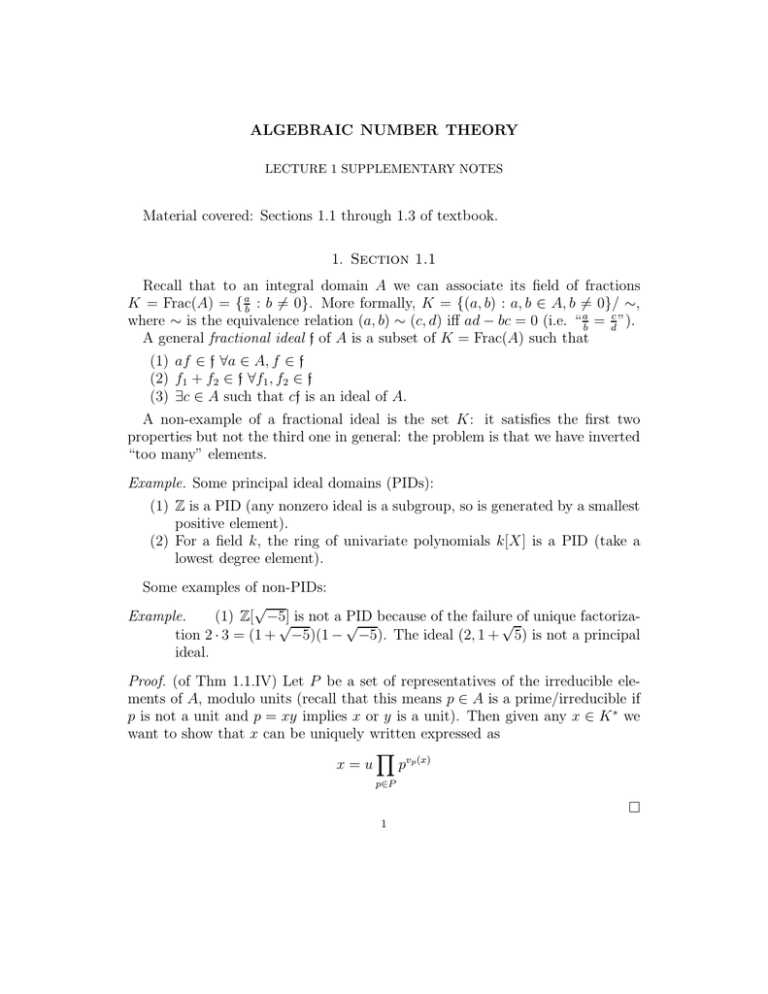
ALGEBRAIC NUMBER THEORY
LECTURE 1 SUPPLEMENTARY NOTES
Material covered: Sections 1.1 through 1.3 of textbook.
1. Section 1.1
Recall that to an integral domain A we can associate its field of fractions
K = Frac(A) = { ab : b =
6 0}. More formally, K = {(a, b) : a, b ∈ A, b =
6 0}/ ∼,
where ∼ is the equivalence relation (a, b) ∼ (c, d) iff ad − bc = 0 (i.e. “ ab = dc ”).
A general fractional ideal f of A is a subset of K = Frac(A) such that
(1) af ∈ f ∀a ∈ A, f ∈ f
(2) f1 + f2 ∈ f ∀f1 , f2 ∈ f
(3) ∃c ∈ A such that cf is an ideal of A.
A non-example of a fractional ideal is the set K: it satisfies the first two
properties but not the third one in general: the problem is that we have inverted
“too many” elements.
Example. Some principal ideal domains (PIDs):
(1) Z is a PID (any nonzero ideal is a subgroup, so is generated by a smallest
positive element).
(2) For a field k, the ring of univariate polynomials k[X] is a PID (take a
lowest degree element).
Some examples of non-PIDs:
√
Example.
(1) Z[ −5]
PID because of the failure
√ of unique factoriza­
√ is not a √
tion 2 · 3 = (1 + −5)(1 − −5). The ideal (2, 1 + 5) is not a principal
ideal.
Proof. (of Thm 1.1.IV) Let P be a set of representatives of the irreducible ele­
ments of A, modulo units (recall that this means p ∈ A is a prime/irreducible if
p is not a unit and p = xy implies x or y is a unit). Then given any x ∈ K ∗ we
want to show that x can be uniquely written expressed as
�
x=u
pvp (x)
p∈P
�
1
2
LECTURE 1 SUPPLEMENTARY NOTES
First show existence of factorization. Uniqueness will follow from lemma III
of Section 1.1. For existence, we can assume x ∈ A since we can write x = x1 /x2
and express x1 , x2 ∈ A in this form, and divide. So now assume x ∈ A. Then
xA is an ideal of A. If it is the entire ring A, then x is a unit and we are done.
Else it is contained in a maximal ideal pA for some prime p. Then p|x so write
x = x1 p. Again if x1 A = A we are done. Else find a prime dividing x1 and so
on. So this gives us a sequence of elements x = x0 , x1 , x2 , . . . where xi+1 = xi /pi
for
some prime pi . Then the sequence of ideals ai = xi A is increasing. The set
ai is an ideal of A, hence it is generated by one element, say y. Then y lies
in some aN and this means that the sequence must terminate at aN , i.e. xn is a
unit. So a finite factorization exists.
2. Section 1.2
Solving Pythagoras’ equation geometrically.
Write the equation as X 2 + Y 2 = 1, where X = x/z, Y = y/z. It is sufficient
to find all rational solutions of this equation. Now we know one point on this
circle, for example P0 = (−1, 0). For any other point with rational coordinates,
it’s clear that the slope of the line joining it to P0 must be rational (the converse
is also not too hard to see). So write
Y
X = −1 +
m
and plug into the equation to get
�2
�
Y
+Y2 = 1
−1 +
m
which leads to the solution Y = 2m/(m2 + 1), X = (1 − m2 )/(1 + m2 ).
Section 1.3 is the Chinese remainder theorem for general rings.
3. gp/Pari example
Example. G = bnfclassunit(x^2+5)
This G contains lots of arithmetic information. For instance G[2, 1] = [0, 1]
gives the number of real and complex
√ embeddings of the number field. G[5, 1][1]
is the class number of the field Q( −5) which is 2. G[5, 2] gives the structure
of the class group in terms of its elementary divisors. Here it has to be Z/2.
Finally, G[5, 1][3] gives the generators of the cyclic components. Here we
√ get a
matrix with colums [2, 0] and [1, 1] which means that the ideal is (2, 1 + 5).
MIT OpenCourseWare
http://ocw.mit.edu
18.786 Topics in Algebraic Number Theory
Spring 2010
For information about citing these materials or our Terms of Use, visit: http://ocw.mit.edu/terms.

